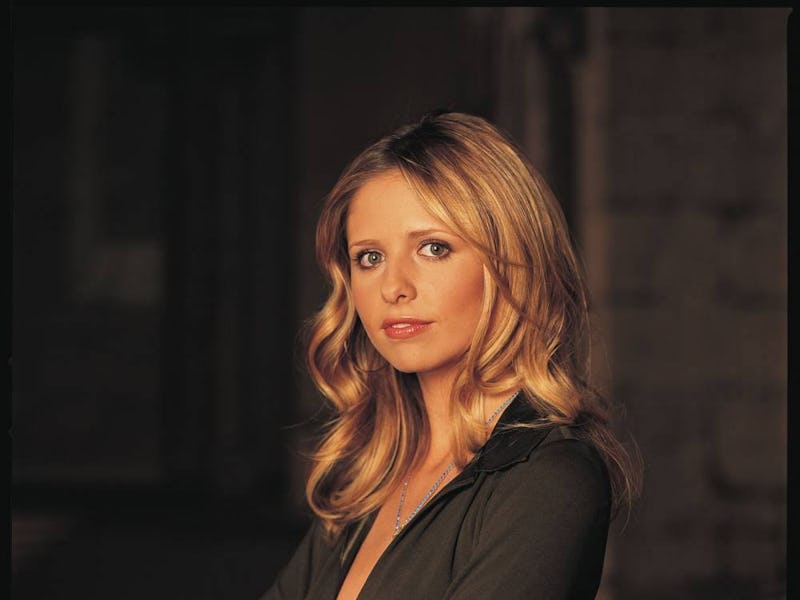11 Whedonverse Episodes to Watch Before They Disappear
From 'Buffy' to 'Firefly,' here are the episodes to watch.

The Whedonverse — otherwise known as Joss Whedon’s body of television work — is vanishing from Netflix in April. This is a tragedy. Although his shows range from sci-fi westerns, to Batman in L.A., to lethal teen girls, to Westworld before it was cool, they all share similar qualities. They have quippy dialogue, complex friendships, tragic romances, and a unique blend of comedy, pathos, and humanity. If you’re interested in surfing the cream of the crop before they vanish, here are the key episodes to note.
11. “Epitaph One,” Dollhouse
Dollhouse is Whedon’s most misunderstood show. It had a similar concept to Westworld before it permeated the mainstream, and between a slow first season and wonky air times, it never truly caught on. Thought it lasted a scant two seasons, the thirteenth episode of Season 1 is where it really matures into its ideas about the consequences of this people-programing technology.
10. “Objects in Space,” Firefly
Whedon’s tragically short-lived, space-western Firefly is infamous for its unjust cancellation. It lasted for one short but bright season of Mal and the gang aiming to misbehave. “Objects in Space,” the Season 1 series finale, is a tour de force.
9. “Storyteller,” Buffy the Vampire Slayer
Season 7 of Joss Whedon’s most famous cult hit, Buffy The Vampire Slayer, is contentious among fans. On the one hand, the show closed with a bang. On the other hand, the season devotes much of its screen time to new characters the audience doesn’t care about (the Potentials). It’s sixteenth episode, however, is one of its best. “Storyteller” shines the spotlight on minor character Andrew, allowing the audience to view Buffy and her friends through his hilariously skewed worldview. In typical Whedon fashion, it isn’t amusing just for the sake of it — it also packs a punch in its emotional journey.
8. “Through the Looking Glass/There’s No Place Like Plrtz Glrb,” Angel
Buffy-spinoff, Angel, is among the darkest of Whedon’s shows. It had unabashedly noir undertones and an antihero seeking redemption and meaning after years of misdeeds. As dark as it could get, however, it was also joyously weird and hilarious at its lightest. Nowhere is this represented better than when Angel and the gang take a jaunt to the weird world of Pylea. As a bonus, it contains the best Joss Whedon cameo of his entire career.
7. “A Hole in the World,” Angel
The fifteenth episode of Angel’s fifth and final season is arguably its most gut-wrenching. In it, Angel and the gang desperately seek a cure for Fred, who is dying as an ancient demon takes over her body. Amy Acker’s Fred is Whedon’s purest and most endearing character. This episode is the Whedonverse at its most philosophical and tragic.
6. “The Body,” Buffy the Vampire Slayer
All fans of Whedon have to come with a natural affinity for tragedy. Buffy’s “The Body” in Season 5 remains the most naturalistic and heart wrenching explorations of death on television to this day. In it, Buffy and her friends react to her mother’s death from natural causes. Hardly anything supernatural happens; the episode merely tracks their grief in real time. It’s the kind of episode you can only watch once, but you can’t not watch it.
5. “You’re Welcome,” Angel
The twelfth episode of Angel’s final season closes the door on Cordelia Chase’s character arc. Although the writing on her character went wonky in Season 4, her evolution from snobby and entitled rich girl to deeply compassionate, mature woman is one of the best in the Whedonverse. “You’re Welcome” is a bittersweet but perfect send-off.
4. “The Zeppo,” Buffy the Vampire Slayer
While shows like Breaking Bad and The Leftovers have made experimental bottle episodes focusing on one character old hat, Buffy pioneered that technique. The thirteenth episode of the third season follows Buffy’s bumbling pal Xander as he has his own mini-adventure. The rest of the gang tries to save the world as usual in the background.
3. “Hush,” Buffy the Vampire Slayer
The tenth episode of the fourth season of Buffy is one of its most frequently lauded hours for good reason. It presents an hour that is almost entirely devoid of the show’s signature dialogue, and it’s every bit as riveting and inventive as any other episode. “Hush” is the writers showing off and flexing their muscles. Every experimental episode of modern supernatural television has roots in “Hush.”
2. “Birthday,” Angel
The eleventh episode of Angel Season 3 is not an obvious choice as one of the ultimate Whedonverse selections. It isn’t the flashiest or most frequently cited hour. But not only does it offer a fascinatingly well-rendered series of alternate realities, it shines a spotlight on Cordelia’s evolution. It’s this episode that pushes her over the edge, from selfish floater to deeply compassionate team player, as she turns down an alternate universe with her ideal future in order to help her friends. “Birthday” stands as a microcosm for Whedon-esque charm and philosophy.
1. “Surprise/Innocence,” Buffy the Vampire Slayer
When Buffy loses her virginity, her boyfriend loses his soul and proceeds to terrorize her. This Season 2 sequence in Buffy elevated it from an entertaining teen show to the revolutionary, groundbreaking feminist parable it is remembered as. It’s in this sequence that supernatural monsters cease being goofy fiction and start standing as metaphors for very real scenarios.
The Whedonverse disappears from Netflix on April 1.